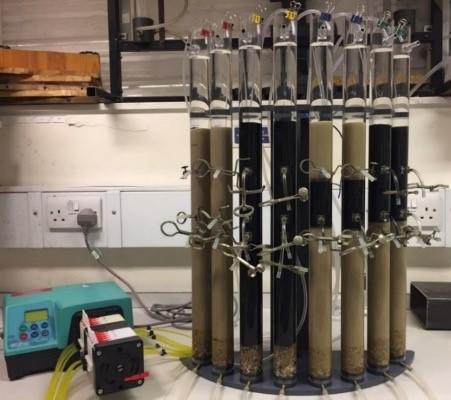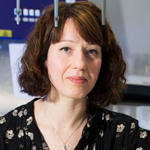Are Victorian water treatment technologies fit for the AMR era?

The Microbiology Society is undertaking a project entitled A Sustainable Future as part of our 75th Anniversary, which aims to highlight the Sustainable Development Goals (SDGs) to our members and empower them to use their research to evidence and impact the goals. Earlier this year, we put a call out to our members to submit case studies in the following three areas: antimicrobial resistance, soil health and the circular economy.
This case study is written by Dr Lena Ciric, who is an Associate Professor and Like Xu who is a PhD Student at University College London. Dr Lena Ciric is a member of the Microbiology Society. The case study focuses on antimicrobial resistance; a naturally occurring process, whereby micro-organisms (bacteria, viruses, fungi and parasites) can change and adapt over time, either by modifying the target of the antimicrobial, or by developing and exchanging resistance genes.
Introduction to the Project
Biofiltration is a drinking water treatment technology that uses biological, as well as chemical and physical processes to purify water. The technology was developed in the early 1800s with the first treated public water supply provided by the Chelsea Waterworks Company in London. Today it is widely used across the globe in municipal treatment works operated by water utilities but can also be used at a much smaller scale serving individual households. But is this technology fit for the 21st century?
What are the challenges/needs that this research/initiative addresses?
Biofiltration involves the passing of water over a filter made of sand or another similar medium, like granular activated carbon (GAC) or anthracite. The filter is usually around 1 metre deep and can have a surface area of less than 1 m2 or be as big as a football pitch. The water is passed through the filter at a relatively slow flow rate to achieve best results. Particles in the water are physically trapped by the filter media, which can also have adsorbent properties to remove impurities. As natural water going into the filters is not sterile, as time goes on micro-organisms deposit on top of the filter, forming a biofilm. This biological layer, known as the schmutzdecke, becomes more complex and biodiverse over time and contributes to the filtration by biodegradation of contaminants.

Figure 1. Lab-scale filter column set-up.
Biofiltration has been shown to be effective for the removal of many contaminants including micro-organisms, solids and toxic compounds such as pesticides. However, in recent years it has become evident that natural water is contaminated with low concentrations of antibiotics as well as antibiotic resistant organisms carrying resistance genes. As biofiltration relies on biological processes carried out by micro-organisms, we were interested to see how the presence of low levels of antibiotics might affect biofiltration and whether the filters provide a good location for bacteria to swap useful genes, such as antibiotic resistance genes.
What findings and solutions were provided by this research/initiative?
In order to investigate this, we set up a number of different filters using different media – sand, GAC and anthracite (Figure 1). We then passed water containing low concentrations of five of the most commonly used antibiotics in the UK into the feed water to see whether the media type would have an impact on antibiotic removal. We also looked to see if the numbers of resistance genes in the filtered water would increase or decrease. Finally, we carried out an experiment to see whether any of the media we were using promoted the transfer of mobile DNA elements carrying antibiotic resistance genes.
The results showed that GAC was the most effective medium for the removal of antibiotics. Overall, GAC was able to remove 95-100 % of all antibiotics tested, whereas sand and anthracite could only remove 60 % and 35% at best, respectively. When looking at the concertation of antibiotic resistance genes before and after filtration, there was an overall reduction in the number of resistance genes but a relative increase in resistant organisms – i.e. the filters removed the majority of the microbes but those that came out in the effluent were more likely to be resistant to antibiotics. When looking at the rates of transfer of antibiotic resistance carrying plasmid in the three different media, we saw that the rate of transfer was 10-fold higher in the GAC than in the sand filters, with transfer rates in the anthracite laying somewhere between the two.
These results suggest that the properties that make GAC so excellent at removing antibiotics from the water may also lead to an increase in the concentration of resistant organisms within the filters, which may then pass the resistance genes to other organisms. Figure 2 shows the structure of the grains of sand, GAC and anthracite at high magnification. It is clear that the GAC possessed a much more intricate surface structure than sand and anthracite. It is likely that this structure allows bacterial cells to interact more with each other leading to the dissemination of antibiotic resistance genes.

How can this research/initiative support the transition to a more sustainable future?
While biofilters are an effective water treatment option, they are a technology developed in a different age before the discovery of antibiotics, before the AMR crisis, before our natural environment was contaminated with antibiotics, resistant organisms and the genes that offer resistance. Investigating the effect this technology has on the dissemination on AMR allows us to make adjustments to ensure that we are providing sustainable water treatment solutions for the future.

About the author
Dr Lena Ciric is an Associate Professor at University College London and is a member of the Microbiology Society. More information about her work is available here.


